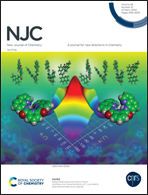Scanning tunneling microscopy study of [1,1:3,1′′-terphenyl]-4,4′′-dicarboxylic acid on HOPG
Abstract
In this work, the interfacial self-assembly behavior of [1,1′:3′,1′′-terphenyl]-4,4′′-dicarboxylic acid (TDA) and the regulation of the introduced guest molecules (trimesic acid (TMA) and coronene (COR)) on TDA's mono-component system were investigated by scanning tunneling microscopy (STM), and the formation mechanism was investigated by density functional theory (DFT). Newly added TMA molecules destroyed the single-row structure formed by TDA self-assembly and formed a new hexagonal co-assembly structure with TDA molecules. When COR was introduced into this system, the co-assembly structure collapsed and the resulting structure was dependent on the concentration of the COR solution.
![Graphical abstract: Scanning tunneling microscopy study of [1,1:3,1′′-terphenyl]-4,4′′-dicarboxylic acid on HOPG](/en/Image/Get?imageInfo.ImageType=GA&imageInfo.ImageIdentifier.ManuscriptID=D4NJ00105B&imageInfo.ImageIdentifier.Year=2024)


 Please wait while we load your content...
Please wait while we load your content...